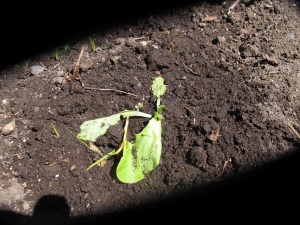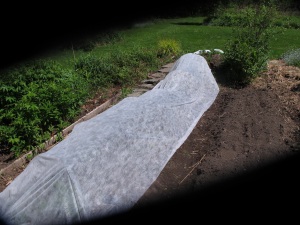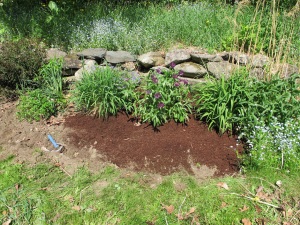Spring Has Sprung!
Posted on Thursday, March 20, 2025 · Leave a Comment
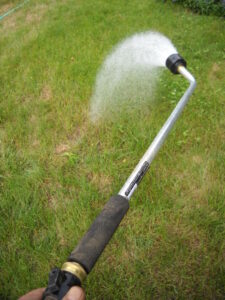
Watering wands get lots of water where you want it.
It’s April, and spring has sprung. Or will soon. Winter always is a sneaky devil, coming back with hard frosts and even a foot of snow on occasion. There is much to do, but start slowly – not just for your back, which has been resting all winter, but because a week of warm sunny days doesn’t mean your soil is warm enough to plant. A soil thermometer pushed 3 inches into the soil should read 50 degrees before planting anything – even spinach and so called cold weather crops.
As you move around your garden you will probably notice that the soil is moist. If you are leaving footprints in the lawn or garden soil, stay off it until it dries out more. Otherwise you can ruin soil structure by compacting it.
You can put down 6-inch planks as walkways in flower beds if you are determined to weed or to remove leaves and debris while the soil is still a bit wet. But even then, be careful. There may be little green noses of perennials or bulbs lurking under the leaves and you won’t want to damage them by putting a plank on them.
I’ve had snowdrops up and blooming since March, as I do every year. By April I have lots of bulbs blooming: crocus, glory-of-the-snow, scilla or squill (a deep purple early bloomer), winter aconite (a bright yellow, short-stemmed beauty) and early daffodils. If you don’t have enough bulbs blooming, imagine where they might go, and put plant labels there for fall planting. A south-facing hillside bed will produce blossoms up to 3 weeks before a north-facing bed.
I plant 100 tulips as cut flowers every year. If you planted some last fall, and have deer in the neighborhood, you may be disappointed to see them eaten just as they are starting to bloom. I prevent this by surrounding and covering my tulip bed with chicken wire before that happens. I plant my tulips in the vegetable garden each fall, and treat them as annuals.
Once your lawn has dried out, it will need a good raking to clean up the winter debris. I like to wait until the lawn has greened up a bit before raking. I don’t want to rake a dormant lawn as it would be easy to damage it with a brisk raking. Think of your lawn as individual plants growing very close together, not as one big green plant. They compete with each other and with crabgrass and weeds. A sprinkling of good compost will improve your soil, giving the lawn a better place to thrive.
I recommend reducing the size of most lawns. Think of a lawn as an area rug, not wall-to-wall carpeting. That will allow you to have a bigger vegetable garden and more places for native trees, shrubs and perennials that will support pollinators and birds. Do you know that caterpillars are essential food for baby birds? We need to provide flowers and trees that the butterflies and moths recognize and use – our natives.

Raised beds are easier to weed and harvest
I recommend raised beds for the vegetable garden, but you don’t have to build or buy wooden boxes for raised beds. When the soil has dried out, loosen it with a garden fork, and then use a short-tined rake to drag soil from walkways onto your designated beds to raise them up six inches or so. A 30-inch wide bed is ideal, it’s wide enough for roots to spread far and wide, yet you will be able to reach all parts for weeding.
Adding compost to your soil every year will improve it greatly over time. An inch of compost works wonders if you do it every year. Buy it in bulk if you have access to a pickup truck, or buy bags if you don’t. And for my tomatoes? I always add a shovel of compost in every planting hole and stir it in well with my favorite weeding tool, the CobraHead weeder. (
www.CobraHead.com). Compost provides not only essential minerals in small quantities, it greatly improves soil texture and its ability to hold water in dry times.
Some people hate weeding, some love it. Either way, it has to be done. Start before the weeds get big. Perennial weeds like dandelions or thistles will already have deep roots. Annual weeds will be tiny, but numerous. I believe the best tool for either is the CobraHead weeder. Its curved metal digging tip can loosen the soil around deep roots, and help you pull from below with the tool while your other hand tugs on the top. Pull gently, slowly. You don’t want to snap off the root, as it will just start growing as soon as you walk away. Annual weeds you can loosen by scuffing the soil lightly.
As you plan your garden, think about buying organically certified starter plants and seeds. Why? Ordinary seed growers feed their plants with liquid fertilizer every day. That means that the plants don’t have to work as hard as organically raised plants to get the minerals they need. Organic practices promote longer roots to get the nutrition needed by the plants. If you are going to grow organic food, you will do best with organic starter plants.
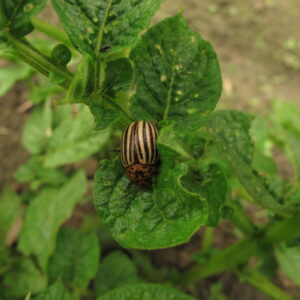
Organic seed producers have to deliver seeds for plants that will not be protected from diseases and pests with chemicals. They have to tough. Lastly, buying organic seeds and plants supports organic farmers. They are working hard to protect the environment by avoiding chemicals. Pay a little bit more if you can, and buy organic.
And remember: gardening is supposed to be fun. Don’t work so hard you get blisters and a sore back. Garden a little every day.
Are Your Plants Suffering from a Drought?
Posted on Monday, September 5, 2022 · Leave a Comment
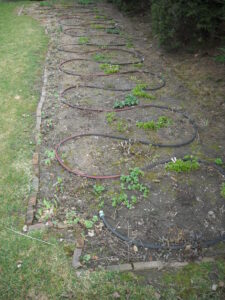
Soaker hoses provide a slow, deep watering. This hose put in place in early spring.
Many of my readers are suffering from a serious drought, enough so that plants are losing leaves and going dormant long before they should. Most well established plants will recover from the effects of drought, even if they lose their leaves now. And new things? If you have not been giving them water weekly or more often, some may die.
Added to the problem is the fact that many places have enacted watering bans or limitations. And wells may not have enough to water everything. And of course, watering takes time – time away from family, dogs, and recreation.
If you have not been thinking about the drought, you should. Start by looking at your plants. Are leaves limp, withered, or turning brown? If so, you need to water them well – today! They need a good deep watering.
Deep watering is not easy. If you take your hose and spray the base of the tree for a minute, you are not actually giving it much water. Wait 10 minutes after watering and go back to the new tree or shrub that you planted last spring. Use your finger or a tool like the CobraHead weeder (a weeding tool with a single tine) to dig down four inches or more. Is the soil moist? It should be. Most roots are in the top foot of soil. Add more water as needed.
If your soil is like powder, it is not easy to get water to penetrate the soil. If your tree is on a hillside, water you apply will run away almost immediately and not soak in at all. Even a gentle slope will allow water to run off. You will need to make a ring of soil or mulch around the tree or shrub to contain water.

Watering Wand
If you are using a hose, use a watering wand to apply water rather than a spray nozzle held in your hand. These wands are usually 24 inches long with a nice “rose” on the end that makes the water flow in a gentle spray and have a valve to turn the water on, off, or part way on. Since the tip of the wand is near the ground, it is less likely to wash away the soil. And it allows you to direct the water just where you want it. Soaker hoses on timers are good if you travel a lot, or vacation when it’s hot and dry.
Before you start watering, learn now much water your hose delivers. Do this by timing how long it takes to fill up a 5-gallon pail. Two or three minutes is usually long enough, but it depends on the diameter of your hose and the water pressure. Half inch hoses are worthless. Five-eighths inch hoses are adequate, and three-quarter inch hoses are good for long distance runs. Five gallons is the minimum quantity of water needed by a thirsty shrub or newly-installed tree.
Most new woody plants need five gallons every week, but it does depend on the soil type. Sandy soil dries out the quickest, and needs the most water. Clay soil holds water, but is hard to get thoroughly moist. Even though I have good soil, I always add compost to the soil when I plant anything. Not only does it add biologically activity, it holds water in sandy soil and loosens up clay soils. I buy it by the truckload. Most garden centers sell it in bulk, which is cheaper than buying it by the bag. Of the bagged compost, I like Moo-Doo and Coast of Maine brands.
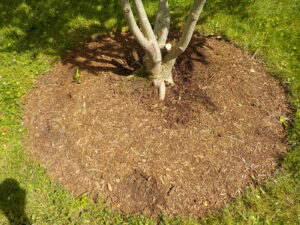
Mulch around a tree will hold in water and help keep weeds from stealing water.
Grasses and weeds suck moisture out of the soil, so dig them out around your trees. Weed a ring around new or struggling trees that is 3 to 4-feet wide. Then get some fine mulch (double-ground mulch, not wood chips). An inch and a half of mulch is about right, or two inches. Deeper than that and short rain showers will never get moisture to your plants’ roots.
Don’t buy bagged wood chips based on price – or if you do, buy the most expensive. Cheap mulch may be ground up and shredded construction debris and pallets. “Color enhanced” mulch is stained or dyed with something and may spread chemicals in the garden – and fade with time.
Never let the mulch touch the bark of your tree, or worse yet, make a faux-volcano of mulch. Mulch can harbor fungi that will rot the bark of your tree, killing it in 6- to 10-years. Once the cambium layer under the bark gets rotted, the tree will die. If you have mulch against any of your trees, please fix it right away.
Years ago I visited my friend Sydney Eddison at her home in Newtown, CT. Sydney is a garden designer, author of many fine gardening books and a poet with terrific gardens. They were in the midst of a terrible drought – so bad that mature oaks were losing their leaves in the forest by August. A water ban was in place, but her gardens looked great.
“Sydney,” I said, “You’ve been cheating and watering your plants.” No, she explained, “It’s all about the mulch”. Each fall her husband, Martin, mowed over all the leaves that fell on the lawns and bagged them. He stored them in the barn until spring, and after all her plants woke up in the spring, she added a layer of chopped leaves. Not only did they hold in moisture, as they broke down they added organic matter to the soil – making it better each year.
This fall, do the same. Collect your leaves, or have the lawn service collect them for you. I don’t bag them up, I just add them to a pile and use as mulch in the spring. It really works. A 2-inch layer is perfect.
Don’t be disheartened if some of your plants go dormant now. It is their way of protecting themselves. But do water if you can – and get it down deep. Your plants will bless you!
Watering in Dry Times
Posted on Tuesday, July 7, 2020 · Leave a Comment
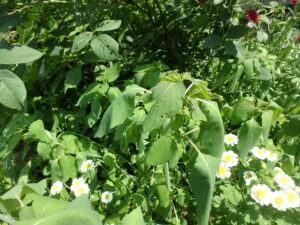
These limp leaves tell me it is time to water
June, for most of us, was a very dry time. When weeds and established perennials started to droop, I knew it was time to water, and I did. But watering done well takes time and, done poorly, wastes a lot of water – or doesn’t do the job. I have no crystal ball to know what the rest of the summer will be like – July started well with plenty of rain – but it’s good to plan ahead
First, how much rain do we need each week to be able to avoid watering? About an inch. If you have sandy soil, water runs right through it, so you need more. Clay soil has tiny soil particles and holds onto moisture nicely. But if clay goes bone dry, it can turn into something like cement that will let water run off the surface and downhill instead of soaking in.
In either case, you can make watering easier and your plants more vigorous by adding compost to your soil. That is easiest to do before planting, of course, but you can top dress the soil with compost and let earthworms, roots and rain work it into the soil over time. Half an inch of compost on the lawn each spring and fall will help a lot. And mulching with compost, an inch or so, will help your flowers and veggies considerably.
In general, I don’t like overhead watering systems. Yes, they do mimic a rain storm, but they waste a lot of water, and water the walkways and weeds as well as the plants. So long as the soil is not parched, I like to water plants using a watering wand.
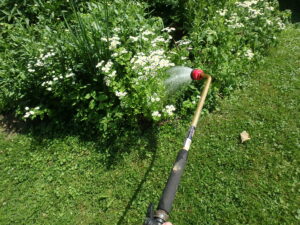
A watering wand directs a soft spray just where you want it
My watering wand is a 30-inch long aluminum tube with a watering rose on the end and a shut-off valve that allows me to increase or decrease the flow of water. I like those made by Dramm, a company that specializes in watering devices and has figured out how to deliver lots of water while not disturbing young plants.
In the vegetable garden, I walk up the rows directing the water around my tomatoes or irrigating the lettuce. The wand allows me to spray water close to the ground level – it’s not falling from waist high, the way a nozzle on the end of a hose would. I place hardwood grade stakes at the end of each row to guide the hose and keep it from damaging plants
But during an extended period of hot and dry weather, I know I need to water each bed entirely, from side to side, but not the walkways. If I just water right around the tomatoes, for example, the surrounding soil will wick away the moisture that you gave to your plants. So you need to soak the soil around your plants, not just at the stem.
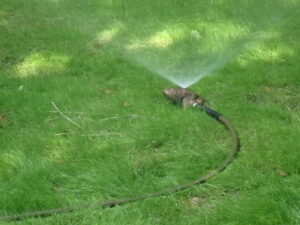
This simple, stationary watering frog waters a circle 20 feet across
When watering newly planted trees, or those planted last year, water in a circle around the tree or shrub that extends at least to the drip line. Later on, when a tree is mature, the roots can go far beyond that. If the soil is dry, you might be surprised how long you need to water around a tree in order to get water to get down 6 or 12 inches – which is where the roots are.
Another way to keep your plants happy in dry times is to mulch them well. This will keep the soil moisture from evaporating and will minimize those thirsty, greedy weeds.
In the vegetable garden I put down 4 to 6 layers of newspapers or a single layer of cardboard or large brown paper bags, and then cover that with straw. To make sure a light rain gets to my plants, I don’t mulch right up to the plants. Or I’ll mulch with chopped fall leaves or grass clippings right next to the plants. Leaves or grass let rain pass through more easily than paper and straw, but keep down weeds.
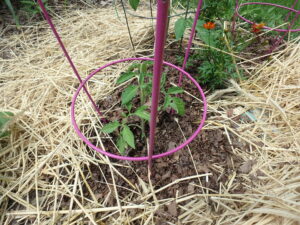
This young tomato is mulched with a circle of chopped leaves, paper, and straw
Why use straw instead of hay? Straw generally costs more than straw – $10 a bale or more versus $5 or less. Mulch hay has seeds, that’s why. Straw is not supposed to have seeds, though occasionally it does. I was told that even if you see seeds in straw, they are immature and won’t germinate.
I don’t like to use black plastic in the garden. It does keep down weeds and holds in moisture, but it ends up in the landfill a year later. And it may interfere with the beneficial microorganisms in the soil – it gets pretty hot under the plastic. It can also create pools of water, a good breeding place for mosquitoes. So I avoid it.
In flower beds I prefer to grow plants so close together that few weeds grow there. But in new beds I use finely ground bark mulch. Never the colored kind, orange or black, as they have chemicals I don’t want.

A flip flop watering device can cover a lot of space
For big areas of new plants or lawn, a sprinkler of some kind is good. I like a Melnor brand flip-flop sprinkler, model XT360 M. It is easy to use, and comes with a lifetime warranty. For small areas, I like a fixed sprinkler like my brass frog that waters calmly in a 20-foot circle.
Plants will usually recover from getting dehydrated, but it takes a week or more, so you lose valuable growing time. I want my tomatoes sooner, not later. So I make sure they don’t dry out too badly in dry times.
If you pay attention to your plant, if you really look at them, you will see when they start to wilt. That’s the time to water. So get a good watering device, and be ready!
Henry can be reached at
henry.homeyer@comcast.net. He is the author of 4 gardening books, and can make house calls to offer advice about your garden if you live nearby. He lives in Cornish Flat, NH.
Thank heavens we finally got some rain. I had less than half an inch in the first 29 days of May. If my plants were puppies, they’d have done a lot of whimpering during that last hot week of the month. They’d have been begging for water, complaining of neglect. There are things we can do to help our plants through hot spells, and it makes sense to think about them now, as summer begins.
Just as EMT’s do at an accident scene, sometimes it’s necessary to perform triage in the garden. Pick the plant that is suffering the most and water it. In principle, I don’t believe that established perennials should need to be watered. Put the right plant in the right place and it should thrive. But after a month without rain, watering may be needed and if you have lots of plants, you need to decide where to begin.
I begin with newly planted things that are stressed. These are the ones that have limp leaves, or, worse yet, are flopping over. The very act of planting disturbs roots and the fine root hairs that suck up water from the earth. If you move a perennial or small tree, you have certainly cut off some of the roots – they extend long distances and you cannot see the finest of their roots. Even a shrub purchased at a nursery and carefully planted will take weeks to settle in. Some shrubs even need extra water in year two after planting. And roses do best with more water than most.
How you water is important, too. I don’t water with an overhead sprinkler. They water everything, including walkways and weeds. I use a handheld device called a watering wand that allows me to get water where I want it – at ground level. The 36-inch wand attaches to the hose and has a nice “rose” on the end that turns a potentially torrential deluge into a strong but gentle shower. There are lots of brands, but I find that “Dramm” brand devices work perfectly every time – and are worth the extra cost. I have a thumb switch on the wand that allows me to turn it off and on, and to regulate the flow.
My lettuce, started indoors by seed and hardened off well, wilted badly after planting last week. I planted at dusk and watered it well, but the next day hit 90 degrees. When I saw it gasping for breath at noon, I gave it a dose of a commercial remedy I use for transplant shock. It is called SuperThrive (all one word) and is made from seaweed extract and plant hormones. A capful in a watering can is all it takes, and it does help.
If you’ve just planted veggies that are suffering from the heat and dryness, think about providing some shade. I covered my lettuce with row cover (also called by trademarked names, Reemay or Agribon). I have wire hoops that I pushed into the soil, then draped this thin layer of synthetic fabric over the hoops and pinned down the edges with landscape staples. It protects the plants from hot, drying winds and reduces the intensity of the sunshine slightly. Air and moisture passes through this fabric, which I also use at times to keep insects off plants.
I also planted a small clematis vine last week, and provided some temporary sun protection simply by simply placing a couple of buckets near it to provide shade in the hottest part of the afternoon. Later I will plant a medium-height flower in front of the clematis to keep the roots shaded and cool, which they like. I’ve been known to use sheets of cardboard to provide shade, or to use a beach umbrella at planting time.
Soils make a big difference in watering needs. Sandy soils dry out and drain fast. Good loam holds moisture nicely. Clay soils can hold too much water, rotting roots in wet times. Adding compost to any soil at planting times helps to achieve that desired “moist, well-drained soil” that gardening articles suggest.
Mulch is good for holding in moisture and discouraging weeds. In the vegetable garden I put down newspaper (4 to 6 sheets thick) covered with straw, hay or leaves. Around bigger plants like tomatoes I leave some open, un-mulched space around the stem. That allows a quick rain or a visit with my watering wand to get moisture to the roots more easily.
In flower gardens I sometimes use finely ground hemlock bark that I buy by the pickup-truck load. Some gardeners like to install landscape fabric under the mulch, but I rarely do that. I find that the worst of the weeds can get through anyway, and their roots become entangled with the fabric, making it tough to remove them entirely.
Chopped autumn leaves are great mulch for gardens. They help to keep down weeds, provide organic matter to soil microorganisms, and hold in moisture. Earthworms love leaves. One gardening friend bags all her leaves after running over them with a lawnmower in September, and stores them for use now.
Weeds, well known garden villains, are not just competing with your onions and lettuce for sun and soil nutrients, they also want the water – especially in dry times. Get your garden off to a good early start this summer by weeding for 15 minutes a day – minimum. I have a lot of garden space and try to spend an hour a day pulling weeds. Once weeds bloom and spread their seeds, the work will multiply exponentially, so do it now and have less work later.
Henry Homeyer is gardening educator and author of 4 gardening books. His website is www.Gardening-Guy.com. You may e-mail questions or comments at henry.homeyer@comcast.net.
 Organic seed producers have to deliver seeds for plants that will not be protected from diseases and pests with chemicals. They have to tough. Lastly, buying organic seeds and plants supports organic farmers. They are working hard to protect the environment by avoiding chemicals. Pay a little bit more if you can, and buy organic.
Organic seed producers have to deliver seeds for plants that will not be protected from diseases and pests with chemicals. They have to tough. Lastly, buying organic seeds and plants supports organic farmers. They are working hard to protect the environment by avoiding chemicals. Pay a little bit more if you can, and buy organic.












